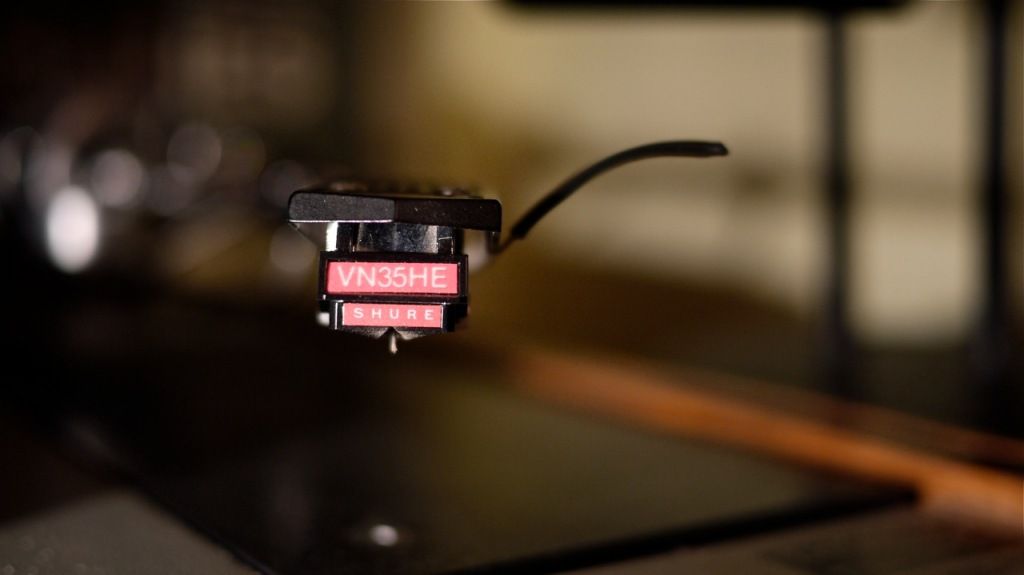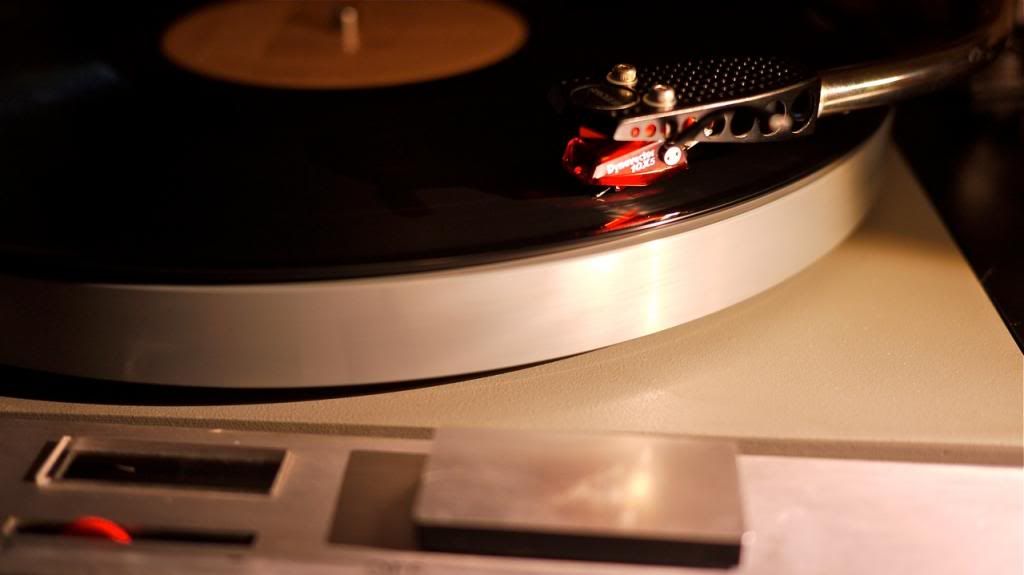Recording Techniques, People Skills, Gear, Recording Spaces, Computers, and DIY
Moderators: drumsound, tomb
-
shedshrine
- deaf.
- Posts: 1868
- Joined: Tue Jun 01, 2004 5:47 pm
- Location: sf bay area
Post
by shedshrine » Tue Apr 23, 2013 1:20 pm
Just got my turntable (ThorensTD125mk2) back after a checkup and new cartridge install. My first experience with a moving coil cartridge.
Before:
 After:
After:

Not experiencing a big "Wow" effect moving from a Shure mm to the Dynavector mc cartridge.
Running the tt with an old HH Scott 12 watt tube amp (222b) with high and low phono inputs.
The "high" input sounds better, but still not very vivid or powerful with this cartridge setup.
Volume knob half way up is adequate volume, but again not that involving.
Does this cartridge require a break in, or is that whole concept hooey.
Or does a mc cartridge need a different kind of phono preamp to shine?
Admittedly the cables on the tt are originals from back in the '60s if that's part of it.
Any ideas or experiences?
Thanks!
M
-
Mudfoot Marshall
- audio school
- Posts: 5
- Joined: Tue Apr 23, 2013 1:42 pm
- Location: Wisconsin
Post
by Mudfoot Marshall » Tue Apr 23, 2013 1:53 pm
shedshrine wrote:Just got my turntable (ThorensTD125mk2) back after a checkup and new cartridge install. My first experience with a moving coil cartridge.
Not experiencing a big "Wow" effect moving from a Shure mm to the Dynavector mc cartridge.
Running the tt with an old HH Scott 12 watt tube amp (222b) with high and low phono inputs.
The "high" input sounds better, but still not very vivid or powerful with this cartridge setup.
Volume knob half way up is adequate volume, but again not that involving.
Does this cartridge require a break in, or is that whole concept hooey.
Or does a mc cartridge need a different kind of phono preamp to shine?
Admittedly the cables on the tt are originals from back in the '60s if that's part of it.
Any ideas or experiences?
Thanks!
M
New carts will need some break-in to open up (more bottom end and smoother mid and top range) the rubber suspension being the biggest culprit as it will become more "free flowing" over a period of about 25-50 hrs.
You would need a MC-to-MM step-up transformer to boost the low output and match the impedance. Although your Dyna is a high-output many people have skipped the step-up and been happy. I have never heard this model personally so I can't speak of what is missing sound-wise.
Have fun,
Jake
-
shedshrine
- deaf.
- Posts: 1868
- Joined: Tue Jun 01, 2004 5:47 pm
- Location: sf bay area
Post
by shedshrine » Tue Apr 23, 2013 2:31 pm
Thanks Mudfoot,
I'll see if putting a few hours on it gets the sound more "free flowing"
If not, like you said, I'll look into the step up boxes.
Found this online:
"The phono section is a 47Kohm MM stage. Use MAG low input. Optimal operation range for the Scott is 5mv so you will need to step up the your MC to 5mv."
-
shedshrine
- deaf.
- Posts: 1868
- Joined: Tue Jun 01, 2004 5:47 pm
- Location: sf bay area
Post
by shedshrine » Tue Apr 23, 2013 9:49 pm
I 've been playing discs all night and dialing in the speakers (JBL Decade 26) presence and brilliance controls, messing with the 222b's eq etc., and the Dynavector has definitely got more air and bass than my technics sporting the old Shure mm cartridge.
Currently I've got the (amplifier)222b's eq flat and Ramsey Lewis' Maiden Voyage is sounding full and open at the moment. Any "fluidity" that wants to follow a break in period is welcome however!
-
Snarl 12/8
- cryogenically thawing
- Posts: 3510
- Joined: Sat Dec 20, 2008 5:01 pm
- Location: Right Cheer
-
Contact:
Post
by Snarl 12/8 » Tue Apr 23, 2013 10:43 pm
How are you correcting for confirmation bias in your observations?
Just Kidding!
But seriously, sometimes I think our ears just need to get used to hearing something different before we can decide if it's better or not. And then, if we like what we're hearing after a while we chalk it up to rubber breaking in and caps getting more fluid and stuff. Has anyone done any measuring of a cartridge response before/after this "break in" period? I'm not saying there's not a break in period, I feel like I've experienced this myself. But I couldn't help wondering if it was just my ears that were breaking in. What's the evidence that that's not the case?
-
shedshrine
- deaf.
- Posts: 1868
- Joined: Tue Jun 01, 2004 5:47 pm
- Location: sf bay area
Post
by shedshrine » Wed Apr 24, 2013 8:39 am
Snarl 12/8 wrote:How are you correcting for confirmation bias in your observations?
Just Kidding!
Yes, the ramifications have been delineated within the perameters.

All I can say is I am enjoying my renewed love affair with this silly hobby.
-
Jim Williams
- tinnitus
- Posts: 1135
- Joined: Sat Jun 03, 2006 8:19 am
- Location: beautiful Carlsbad, CA
-
Contact:
Post
by Jim Williams » Sat Apr 27, 2013 8:52 am
MC carts are lower impedance and output levels. I would avoid step-up transformers as those inject another low pass function and also have insertion losses that will eat a couple of db's of noise floor. Jensen makes the best model if you want that route.
Better are specific MC preamps designed with very low noise input transistors. There are plenty available including kits and DIY designs for low cost. Those will offer better transparency and noise specs.
Jim Williams
Audio Upgrades
-
themagicmanmdt
- george martin
- Posts: 1347
- Joined: Mon Nov 13, 2006 8:47 pm
- Location: home on the range
Post
by themagicmanmdt » Sat Apr 27, 2013 11:41 pm
what jim said
yeah
we are the village green
preservation society
god bless +6 tape
valves and serviceability
*chief tech and R&D shaman at shadow hills industries*
-
shedshrine
- deaf.
- Posts: 1868
- Joined: Tue Jun 01, 2004 5:47 pm
- Location: sf bay area
Post
by shedshrine » Sun Apr 28, 2013 12:38 pm
Thanks.
Well, right channel is going out on the HH Scott's phono outputs,
so swapped in my other ancient piece, a MAC1500. It has two (high and low) phono inputs as well:
one rated at 5.6 MV and the other at 2.8 MV.
"The sensitivity is the minimum voltage you need from the cartridge to get the receiver to provide it's full output power. For any given position of the volume control, the sound will be louder if the turntable is in the more sensitive 2.8 mV input compared to the 5.6 mV input.
If the 2.8 mV is too loud and maybe a bit distorted, use the 5.6 mV input. If when using the 5.6 mV input, you have to turn the volume control way up to get the loudness you want and / or if the sound is maybe a bit noisy, use the 2.6 mV input."
In any case, what this translated to for my system was this. I've got the Technics with the Shure mm on the high, and the Thorens with the Dynavector mc on the easier to drive low.
The Thorens/Dynavector mc cartridge low input combo sounds clear and strong with amp controls flat.
The Technics/Shure mm cart high input has a strong midrange, and with the loudness engaged the added presence on top and thankfully non-muddying non-tubbifying low end even with the volume up a bit. Thicker tone though, not as resolved.
 But of course now the Macintosh's left channel is making intermittent static noise in the phono modes.
But of course now the Macintosh's left channel is making intermittent static noise in the phono modes.
-
Bill @ Irie Lab
- suffering 'studio suck'
- Posts: 401
- Joined: Wed Dec 03, 2003 10:53 am
- Location: Boston, USA
-
Contact:
Post
by Bill @ Irie Lab » Thu May 09, 2013 6:36 pm
From an Old-School audiophile turned engineer - As mentioned above moving coil cartridges have a much lower output and impedance than moving magnet cartridges.
The coil moving in a magnetic field has far less mass than a tiny magnet wiggling in a coil structure, so they are more responsive. The drawback is they need added gain to feed.a standard preamp phono section.
This is accomplished by using an outboard small signal active amplification stage (a head amp) or a transformer akin to the type used for ribbon microphones (according to Jensen, they are the exactly same winding).
Audiophile publications The Absolute Sound or Stereophile publish special equipment issues that will show what's available and give recommendations.
***WARNING - THESE SUCKERS CAN BE MUCHO EXPENSIVE and are very susceptible to hum and RF interference ***
Enjoy the vinyl!
PS I had that same Thorens model, loved it and wish I hadn't sold mine.
I&TC - Intonation and Technology Company
Irie Lab Sound Studios
***** Sound Science & Soul *****
Who is online
Users browsing this forum: No registered users and 96 guests




